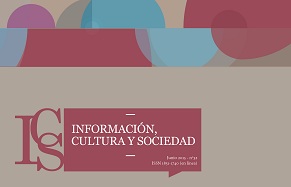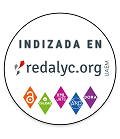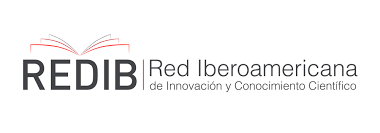NeoCartography and geoliteracy: How the representation of cartographic materials in information systems intervenes in the search practices of geography community
Abstract
This research will analyze the adequacy of the representations of cartographic resources included in information retrieval systems to the search and access needs of the community specialized in Geography. Among the proposed objectives are to survey such systems at the public, governmental and national levels; to identify the metadata standards or schemes used and to study the ways of searching, accessing and using these resources. The work methodology to be implemented will be based on a descriptive-exploratory quantitative-qualitative approach to be developed in three phases or work stages. The first phase will be devoted to the analysis of the representations based on the identification of the systems and the subsequent application of evaluation criteria and instruments to carry out the observation. The second phase will include a survey of the selected population to learn how users access the information contained in the cartographic resources, which will be complemented with semi-structured interviews based on a purposive sample of key subjects. In a third stage, the results of phase one and two will be analyzed comparatively in order to identify the relationships between the representations, the existing systems and the expectations and search needs of the users.Downloads
References
Aber, Susan E. W. y Aber, Jeremy W. 2017. Map librarianship: a guide to geoliteracy, maps and GIS resources and services. Cambridge: Chandos Publishing.
Anglo-American Cataloguing Rules (2nd ed., 2002 revision, 2003, 2005 update). 2002-2005. Ottawa: Canadian Library Association: Chartered Institute of Library and Information Professionals; Chicago: American Library Association.
Argentina. Ministerio de Ciencia, Tecnología e Innovación Productiva. 2016. Resolución 753 - E/2016. <https://www.argentina.gob.ar/normativa/nacional/resoluci%C3%B3n-753-2016-267833/texto> [Consulta: 10 Mayo 2023]
Argentina. Ministerio de Ciencia, Tecnología e Innovación Productiva. 2016. Resolución N° 753, Art. 14. <https://www.argentina.gob.ar/normativa/nacional/resoluci%C3%B3n-753-2016-267833/texto> [Consulta: 10 Mayo 2023]
Bernabé-Poveda, Miguel Ángel y Carlos Manuel López-Vázquez. 2012. Fundamentos de las Infraestructuras de Datos Espaciales. Madrid: Universidad Politécnica de Madrid.
Cea D’Ancona, María de los Ángelees. 1996. Metodología cuantitativa: Estrategias y técnicas de investigación social. Madrid: Síntesis.
Frías Montoya, José Antonia. 1996. Los registros bibliográficos y las necesidades de los usuarios. En Scire. Vol. 2, no. 1, 23–50. <https://doi.org/10.54886/scire.v2i1.1048>
García Calatayud, María del Carmen. 1998. Material cartográfico. En Díez Carrera, Carmen, coord. Los materiales especiales en las bibliotecas. Madrid: Trea. p. 263-312.
Hoffman, Gretchen L. 2009. Meeting users’ needs in cataloging: what is the right thing to do? En Cataloging & Classification Quarterly. Vol. 47, no. 7, 631-641. <https://doi.org/10.1080/01639370903111999>
Infraestructura de Datos Espaciales de la República Argentina IDERA. 2023. ¿Qué es una IDE? <https://www.idera.gob.ar/index.php?option=com_content&view=article&id=530&Itemid=703> [Consulta: 10 Mayo 2023]
Iniesto, María y Amparo Núñez, coord. 2014. Introducción a las Infraestructuras de Datos Espaciales. Madrid: Centro Nacional de Información Geográfica (CNIG), Dirección General del Instituto Geográfico Nacional (IGN).
Kraak, Jan Menno. 2001. Settings and needs for web cartography. En Kraak, Jan Menno y Allan Brown, eds. Web cartography developments and prospects. London: Taylor & Francis. p. 1-7.
Krygier, John y Peoples, Deborah C. 2003. Geographic information literacy and the World Wide Web. En Peterson, Michael. Maps and the Internet. Amsterdam: Elsevier. p. 17-33.
McDonald, John D. y Michael Levine-Clark. 2017. Encyclopedia of Library and Information Sciences. Boca Raton: CRC Press. Vol. 2.
Marradi, Alberto, Nélida Archenti y Juan Ignacio Piovani. 2010. Metodología de las ciencias sociales. Buenos Aires: Cengage Learning.
Mazzitelli Mastricchio, Malena. 2023. Apuntes de cátedra Seminario Prácticas Socioeducativas Territorializadas: La biblioteca sobre rieles. El transporte tranviario porteño y su cartografía: acceso, dinámicas de significación e identidad cultural. Buenos Aires: Universidad de Buenos Aires. Facultad de Filosofía y Letras. [Inédito].
Monteagudo López-Menchero, Jesús. 2001. Tipología del documento cartográfico. En Jiménez Pelayo, Jesús y Jesús Monteagudo López-Menchero, coord. La documentación cartográfica: tratamiento, gestión y uso. Huelva: Universidad de Huelva. p. 115-180.
Ormeling, Ferjan y Bengt Rystedt, eds. 2015. El mundo de los mapas. Berna: International Cartographic Association. <https://icaci.org/files/documents/wom/IMY_WoM_es.pdf> [Consulta: 10 Mayo 2023].
Parry, Bob. 1999. Finding out about Maps. En Journal of Geography in Higher Education. Vol. 23, no. 2, 265-271. <https://doi.org/10.1080/03098269985551>
Poplin, Alenka, Wendy Guan y Ben Lewis. 2017. Online survey of heterogeneous users and their usage of the interactive Mapping Platform WorldMap. En The Cartographic Journal. Vol. 54, no. 3, 214-232. <https://doi.org/10.1080/00087041.2016.1229248>
Reitz, Joan M. 2014. ODLIS Online dictionary for library and information science. <https://odlis.abc-clio.com/> [Consulta: 10 Mayo 2023].
Savolainen, Reijo. 2007. Information behavior and information practice: Reviewing the “umbrella concepts” of information-seeking studies. En The Library Quarterly. Vol. 77, no. 2, 109-132. <https://doi.org/10.1086/517840>
Strader, C. Rockelle. 2021. Cataloging to Support Information Literacy: The IFLA Library Reference Model’s User Tasks in the Context of the Framework for Information Literacy for Higher Education. En Cataloging & Classification Quarterly. Vol. 59, no. 5, 442-476. <https://doi.org/10.1080/01639374.2021.1939828>
Authors publishing in this journal acknowledge the conditions below:
- Authors retain the copyright of their work while they transfer the right of the first publishing to the journal, under the Creative Commons Attribution-ShareAlike 4.0 International (CC BY-SA 4.0) Licence, which allows third parties to reproduce them under the condition that express mention is given to the author and to its original publication in the journal.
- Authors may enter into other contractual and independent arrangements for the non-exclusive distribution of the version of the article published in this journal (for instance, it can be published in an institutional repository or in a book). In any case, an express mention should be given to its first publication in the journal.
- It is permitted and encouraged to publish online the articles (for example, on institutional or personal pages).


























